| ---ON
THE OTHER HAND, he also says, all that glows green under a black light,
is NOT vaseline! The term “vaseline” is a latter-day term for 19th century glass that the makers called “canary” - after the color of the bird. Around 1900-1910, the dealers started calling it VASELINE, due to its similarity to the color of petroleum jelly of the day. The term to Europeans means any kind of creamy yellow glass shading to white, a coloring which resembles vaseline ointment as it used to be. In America, the term means specifically any kind of transparent yellow-green glass which glows brightly under ultra-violet light because it contains uranium. |
|
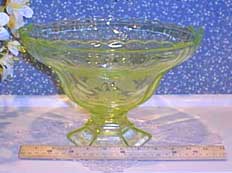 |
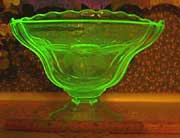 |
| A Rose Sprig pattern punch bowl in natural light on the left & the same bowl under the influence of ultraviolet rays on the right. | |
| Some glass which is blue, green depression, custard, burmese, teal or yellow in natural light might glow under a black light, but in order to fit the definition of VASELINE glass in America, it must be yellow-green in natural light AND glow. Over the years from 1840-1999 canary/vaseline glass will vary in color intensity and hue with changes occurring about every twenty years. There are also changes from manufacturer to manufacturer and even by the same manufacturer, due to lack of quality control, as seen in the examples below. | |
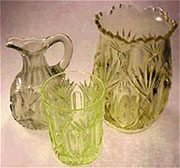 |
Becky
Lyle, of EAPGlass, describes her 3 pieces of Riverside's DERBY pattern, “The
cruet is nearly clear blue-green, the tumbler is true yellow green and the celery is Bud Light ;-)”. |
| From
1840 (when it was first made) to 1863 (when soda-lime was invented),
flint glass made with uranium salts has a very, very saturated yellow
color- with almost a sheen to it. Viewed in sunlight, the green overtone
can be seen. The vaseline glass made in Bohemia during this time was
a much brighter yellow-green, referred to as 'Annagleb', named after
the inventor of this shade of glass. For an example of this glass, see
the intricately engraved flint spill holder at Right. After ca 1863, when the soda lime formula was invented, the traditional formula was modified, as lead was no longer used in the mix. This resulted in the color becoming a very pale yellow although in both cases, 1-2% of uranium salts was still being used to color the glass. |
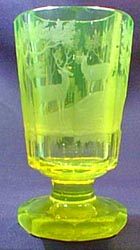 |
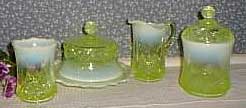 |
An opalescent vaseline table
set in the Diamond Spearhead pattern by Northwood Glass Co. ca 1900. |
| Some factories which produced vaseline/canary colored EAPG tableware included Northwood, McKee, Bryce Bros., Bellaire Goblet Co, Canton Glass Co., Richards & Hartley, A J Beatty & Co., Indiana Tumbler & Goblet Co., Jones Cavitt, Hobbs Brockeunier & Co., Riverside Glass Works, Model Flint Glass Co., Albany Glass Co. Campbell Jones & doubtless many others. | |
A rare
pair of vaseline oil lamps in the APOLLO pattern by the Adam's Glass
Co. ca 1875. |
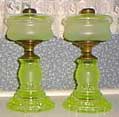 |
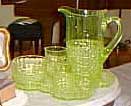 |
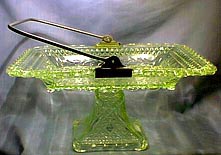 |
| The water set on the left, including a water pitcher, 2 tumblers, waste bowl and tray, is a pattern we've been unable to identify. But the elegant bread tray on the right is a WILDFLOWER pattern tray on an ASHMAN pattern base by the Adam's Glass Co. ca 1875. For some more vaseline "eye candy", check out Steve & Radka Sandeman's vaseline contributions to our Virtual Museum by clicking HERE. | |
| By
the 1920's and 30's, some vaseline glass was being made, but the color
was going out of vogue. Fostoria and Cambridge made some beautiful vaseline
glass during the depression years that is true vaseline, but it looks
different than what was made during 1885-1895. Fenton's 'Topaz' made
during the early 1940's, again took on a different shade as did Fostoria's
HEIRLOOM pattern from 1959. Today's
vaseline glass is a very harsh yellow-green (when compared to the glass
made in 1885), but it still uses 1-2% of uranium salts to color it. Vaseline glass has been at least called the following names during the past 160 years: CANARY, ANNAGLEB, VASELINE, CANARIA (by Pairpoint), TOPAZ (by Fenton and others), YELLOW (Fostoria Heirloom pattern), JASMINE (Duncan & Miller) and probably others. The preferred term for this interesting glass by the majority of collectors is vaseline. One can call it whatever they want, of course, but if they want others to know what they are talking about, they tend to use the word "vaseline" to be understood. |
|

